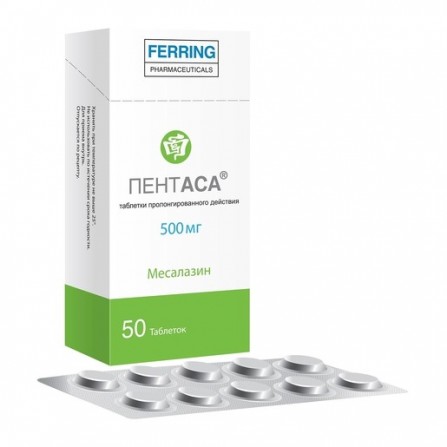Pentas pills with prolonged action 500mg N50
Condition: New product
1000 Items
Rating:
Be the first to write a review!

More info
Active ingredients
Mesalazine
Release form
Pills
Composition
Active ingredient: mesalazine (mesalazine) Active ingredient concentration (mg): 500mg
Pharmacological effect
An anti-inflammatory drug used to treat Crohn's disease and NUC. It has a local anti-inflammatory effect due to the inhibition of neutrophilic lipoxygenase activity and the synthesis of prostaglandins and leukotrienes. It slows down the migration, degranulation, phagocytosis of neutrophils, as well as the secretion of immunoglobulins by lymphocytes. It has an antibacterial effect against E. coli and some cocci (manifested in the large intestine). It has an antioxidant effect (due to its ability to bind to free oxygen radicals and destroy them). relapse in Crohn's disease, especially in patients with ileitis with a long duration of the disease. The therapeutic effect of mesalazine is manifested as a result of local contact of the drug with Zist shell intestines. After ingestion, the tablet disintegrates into microgranules, which act as independent forms of the drug with a slow release of mesalazine. This provides a therapeutic effect of the drug from the duodenal ulcer to the rectum at all pH values. Microgranules reach the duodenum within the first hour after taking the pill. The passage of the drug in the intact small intestine when ingested is carried out within 3-4 hours
Pharmacokinetics
Absorption and distribution Approximately 30-50% of the dose taken is absorbed mainly in the small intestine. Mesalazine binds to plasma proteins 43%, and N-acetyl-5-aminosalicylic acid is 73-83%. Mesalazine and its metabolites do not penetrate through BBB . Cumulative properties occur when using high doses of the drug - 1500 mg / day. Metabolism and elimination Mesalazine undergoes acetylation in the intestinal mucosa, in the liver and, to a small extent, enterobacteria, forming N-acetyl-5-aminosalicylic acid. / in the introduction of the dose of 500 mg is 18.0 l / h. Mesalazine and its metabolite are excreted in breast milk, urine and feces.
Indications
nonspecific ulcerative colitis; Crohn's disease.
Contraindications
- blood diseases; - peptic ulcer of the stomach and duodenum; - glucose-6-phosphate dehydrogenase deficiency; - hemorrhagic diathesis; - severe renal failure; - severe liver failure; - last 2-4 weeks of pregnancy; - lactation period; - children age up to 2 years; - hypersensitivity to the components of the drug. The drug should be used with caution in the first trimester of pregnancy, in case of hepatic and / or renal failure.
Precautionary measures
Caution should be used in case of hepatic and / or renal failure.
Use during pregnancy and lactation
The drug should be used with caution in the first trimester of pregnancy.
Dosage and administration
The dose of the drug is selected individually. Patients Ulcerative colitis Crohn's disease Exacerbation stage Supportive therapy Exacerbation stage Supportive therapy Adults up to 4 g / day in several doses 2 g / day in several doses up to 4 g / day in several doses Children 20-30 mg / kg / day in divided doses The maximum daily dose of the drug is 6-8 g / day. The average duration of treatment is 8-12 weeks. The maximum duration of treatment, including supportive and anti-relapse therapy, is not limited. The criterion for the effectiveness of therapy is the achievement of clinical and endoscopic remission.
Side effects
On the part of the digestive system: nausea, vomiting, heartburn, diarrhea, loss of appetite, abdominal pain, dry mouth, stomatitis, increased activity of hepatic transaminases, hepatitis, pancreatitis. On the part of the cardiovascular system: feeling of heartbeat, tachycardia, increase or decrease in blood pressure , chest pain, shortness of breath, pericarditis, myocarditis. For the central nervous system and peripheral nervous system: headache, tinnitus, dizziness, polyneuropathy, tremor, depression. For the urinary system: proteinuria, hematuria, oliguria , anuria, crystalluria, nephrotic syndrome. From the hematopoietic system: eosinophilia, anemia (including hemolytic, megaloblastic, aplastic), leukopenia, agranulocytosis, thrombocytopenia, hypoproteinemia. Allergic reactions: skin rash, zid-zyr, zid-zyrocytopenia. bronchospasm. Others: weakness, parotitis, lupus-like syndrome, oligospermia, alopecia, decreased tear fluid production, photosensitization.
Overdose
Symptoms: nausea, vomiting, gastralgia, weakness, drowsiness. Treatment: gastric lavage, the appointment of laxatives, symptomatic therapy.
Interaction with other drugs
With the simultaneous use of Pentas enhances the hypoglycemic effect of sulfonylurea derivatives, ulcerogenicity of GCS, the toxicity of methotrexate and the action of anticoagulants. With the simultaneous use of Pentas reduces the activity of furosemide, spironolactone, sulfonamides, rifampicin.
special instructions
Treatment of patients with impaired liver or kidney function is possible only after assessing the degree of their severity. During the entire course of treatment and, especially, at the beginning, kidney function (level of creatinine in the blood) should be monitored regularly. If you suspect pericarditis, myocarditis, and changes in the formula blood should be interrupted treatment. Manifestations of the above adverse reactions can serve in case of pronounced pathological changes in the blood composition - increased bleeding, subcutaneous hemorrhages, sore throat and fever; with pericarditis and / or myocarditis - fever and chest pain in combination with shortness of breath. In some cases, an allergic reaction to sulfasalazine may develop intolerance to the drug Pentas (risk of allergy to salicylates). Patients who are slow acetylators, have an increased risk of side effects . It is possible to stain urine and tear fluid in yellow-orange color, staining soft contact lenses. Effect on ability to drive vehicles and control mechanisms The drug does not affect the ability s to drive vehicles and management mechanisms.




